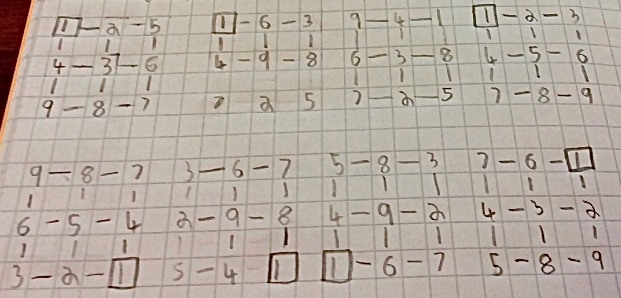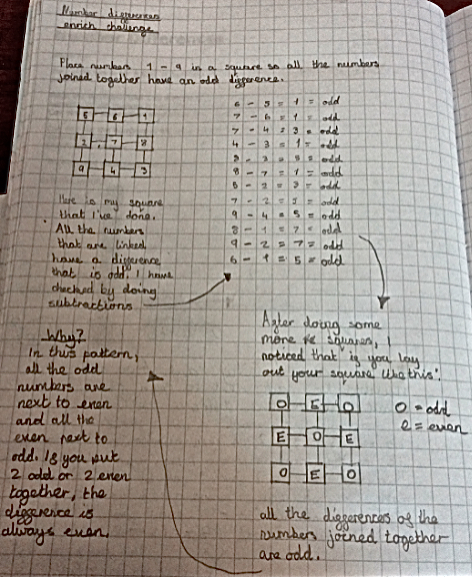Copyright © University of Cambridge. All rights reserved.
'Number Differences' printed from https://nrich.maths.org/
Show menu
Thank you to everybody who sent us their ideas about this problem. The Maths Club from St Peters Catholic Primary school sent in this explanation:
It is easy to make all the differences odd - by using consecutive numbers forwards and backwards. We need to have at least one odd number in each row or column. We could not find a solution where all the differences were even, we think you would need one more odd or even number to fullfill that criteria, or if we could use one of the numbers twice.
Good ideas! I wonder which rows and columns need to have one odd number in them, and which need to have more than one? I'm also not sure that just adding in one more number will help us make all of the differences even - I think we might need to add in some more numbers to make that possible.
Springvale Primary School sent in solutions from: Nathan, Meg, Hannah, Martha, Oliver, Anton, Mayra, Alice, Cameron, Laurence, Georgina, Eddie, George, Freya, Emily, Abigail, Ewan, Lara, Jack, Emilia, Scarlett, Cara and James.
Alice and Cameron's picture was:

You've found a lot of solutions! I wonder if we could work systematically to find all of the possible solutions? Or do you think there would be too many possibilities?
Freya's picture was:

Well done for finding a general solution, Freya. The children in Year 5 at Heathlands Primary Academy also described the same general solution:
We found out that we needed to place the numbers so that even numbers were connected to odd numbers in order to have an odd difference. This meant we could mix the numbers up and find multiple ways of arranging the numbers in the grid.
E.g.:
5 4 7
6 9 2
1 8 3
We then tried the extension task of trying to arrange the numbers so that the difference between the connected numbers was always even. This was harder because we found that we either had to match even with even or odd with odd. We didn't have enough even or odd numbers to make the grid. We couldn't connect even and odd numbers as that would always leave an
odd difference. We could find ways to complete this using our own numbers between 0-20 - either by using all odd numbers or all even numbers.
Ayati from Wimbledon Chase Primary School in England had the same idea about making all of the differences even:
I moved on to the second question. This time there should have been an even difference. I tried many different possibilities but finally had to conclude that this was impossible. I believe the reason for this is because odd and odd make even and even and even make even, however odd and even make odd so the whole shape would either have to be odd or even. There are not enough numbers to do this so it is impossible to do with the numbers 1-9.
That's right, Ayati - we would either need all of the numbers to be even or we would need all of the numbers to be odd.